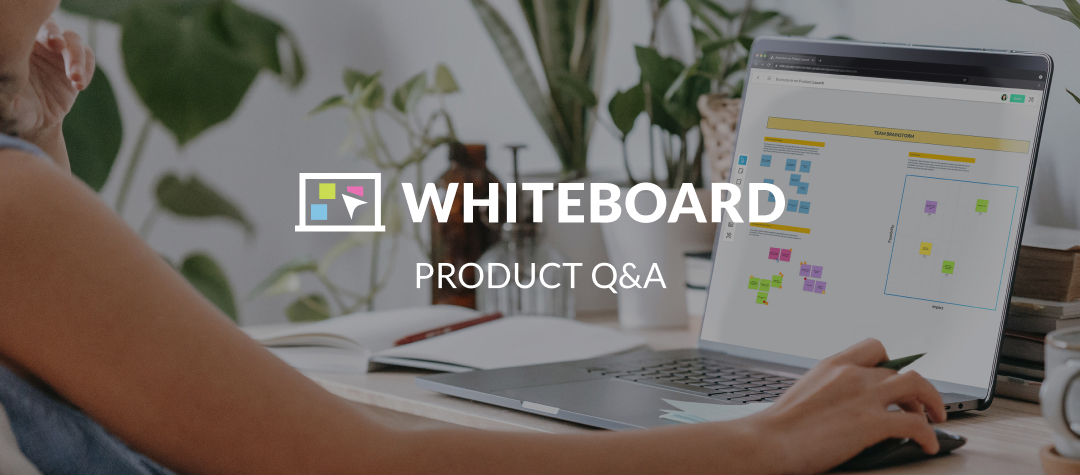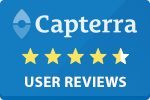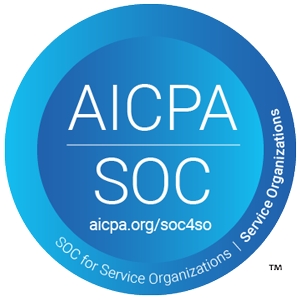A look inside the journey to building a better way to brainstorm
Brightidea recently announced Whiteboard, a new hybrid work software that empowers professional teams to move ideas from brainstorming to actionable projects. The product was designed to allow everyone to collaborate in an infinite, zoomable interface at the same time from anywhere in the world.
As with any launch, it takes a village to develop and prepare a new product for release. After Whiteboard was introduced, two key members of the product team took a few moments to reflect on the journey to launching Brightidea Whiteboard and the commitment of the entire team to ensuring no great idea was left behind.
Katlin Arps, Director of Strategy and Innovation, and Lead Product Designer Chris Clobus brought varying perspectives to the product launch effort. Arps, who joined Brightidea earlier this year, arrived just at the start of the product development cycle and led efforts to define the market opportunity and product features. In contrast, Clobus has been with the idea management solution provider for more than a decade through scores of product launch cycles, and he wore many hats while owning the core user experience. Here’s what they had to say about bringing Brightidea Whiteboard to market.
What was the thinking behind building Brightidea Whiteboard?
Katlin Arps: We wanted to accomplish several things with Brightidea Whiteboard. We wanted to meet users where they had a need, we wanted to create a path from whiteboard to workflow, and we wanted to make it easy to use.
“Whether you’re a visual thinker or prefer to strategize by yourself, your output shouldn’t be constrained by the software—we wanted to make sure we supported the different ways that people think.”
We know that the lifecycle of an idea is never as linear as people make it out to be. We wanted to introduce a product that could meet the user where they are at any given step in that entire thought process. Whether you’re a visual thinker or prefer to strategize by yourself, your output shouldn’t be constrained by the software—we wanted to make sure we supported the different ways that people think.
In a physical space, when you have a brainstorming session there’s all this energy, excitement, and momentum, but then everybody leaves. The leader of the brainstorm is left with the burden of documenting what was generated in the session and figuring out how to carry the ideas forward. We saw the same thing happening with digital whiteboard platforms—ideas get stuck on the whiteboard and stay there. Creating a linkage between the whiteboard and assigning next steps in a workflow is a way to ensure no ideas are left behind.
The other thing that we all suffer from is an abundance of tools. One study found that the average user switches between 35 different applications more than 1,100 times a day—you shouldn’t need to use 35 different tools to get your job done. We really wanted to make sure we were providing a way for people to capture the momentum of their brainstorming sessions, however they structure them, and then had an easy way to build on that momentum to get people through the entire lifecycle of their idea and do it all in one place.
Chris Clobus: Ideas can get stuck in traditional tools, and Brightidea Whiteboard is a gateway to connect your brainstorms back into the Brightidea innovation platform. That makes your working day more efficient, more accessible, not only for you but for anybody that you’re collaborating with.
When the pandemic forced people to work remotely, it removed the physical constraints of being in an office. We wanted to remove the digital barriers as well, so instead of 4 walls, you have an infinite canvas workspace. The pandemic gave us time to explore the tech of modern-day tools, remote work gave us a reason to build.
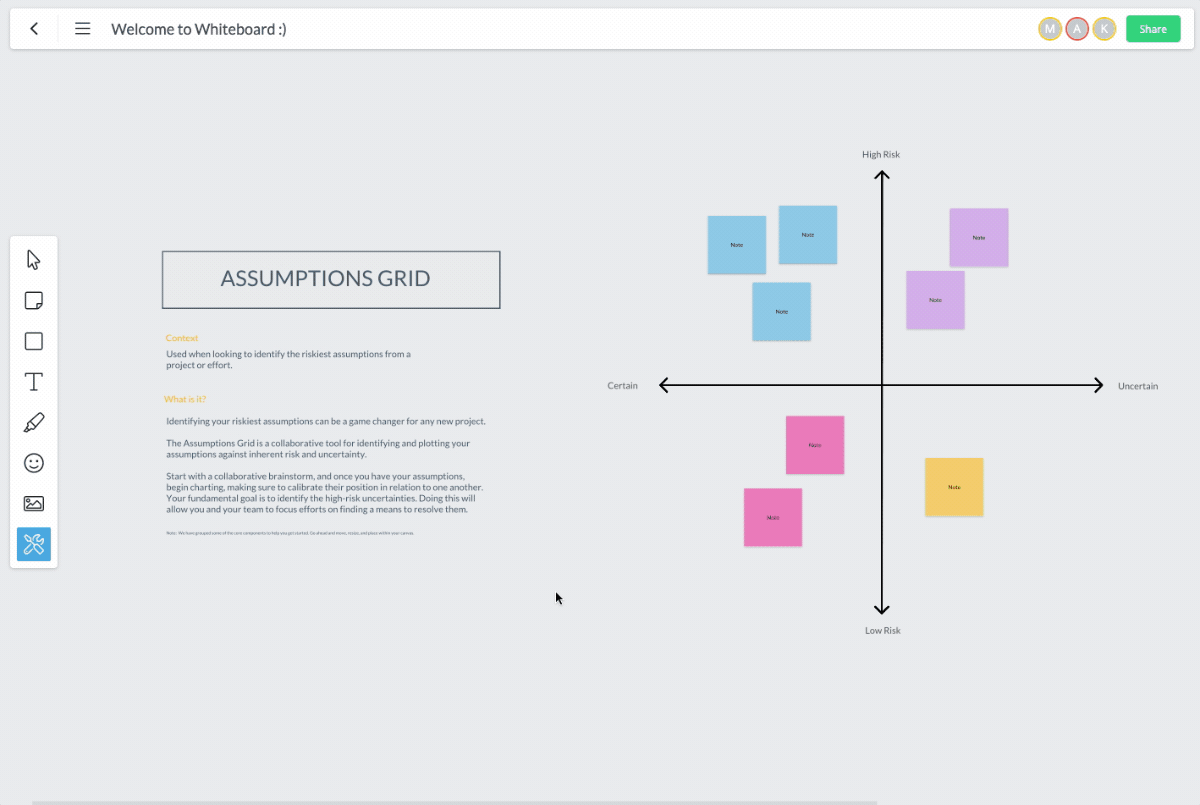
How did the team approach building Brightidea Whiteboard?
Arps: There were 3 big boulders that we focused on pushing up the hill along the path to building Brightidea Whiteboard. The first was creating a collaborative space with best-in-class features. You see that in features like multiplayer, infinite canvas, and calling a huddle with others in the workspace. The second was that we wanted to share our innovation process—our collective years of understanding the process of idea management and how to scale it across an organization—so that we aren’t just creating a whiteboard tool, “We aren’t just creating a whiteboard tool, we’re defining what Brightdea thinks a whiteboard can be.” we’re defining what Brightdea thinks a whiteboard can be. Third, we wanted to drive action so that users were able to facilitate the forward movement of their ideas with features like clicking a sticky note on the whiteboard and assigning it to an owner and an innovation pipeline so that all progress and ROI can be tracked from the first ideation.
Clobus: Flipping that metaphor a bit, I like to think of each of those boulders as circles in a Venn diagram and right in the middle is the sweet spot where everything overlaps. That’s where the magic happens. That’s where we aimed to solve important problems for our customers that the competition had not.
Along with those “boulders,” our internal goal for the product was that it could be used 100% of the time without reliance on another tool. Brightidea Whiteboard isn’t an add-on—it had to be a good experience. If we can’t use it ourselves, how can we expect our customers to do the same?
Something that made building Brightidea Whiteboard exciting for our product and engineering teams is that it’s built on technology that was new to us. Previously we’d used common web-based tech, but in this case, we learned a new language as we developed the product. It’s built on WebAssembly using Rust and WebGL. Now we’re going all the way from the browser to the GPU level, which boosts our horsepower to an entirely different level. Adopting that virtual reality and video game technology was critical to giving Whiteboard an infinite canvas, but it also changed the way we worked, from how we built code to how we tested and deployed it.
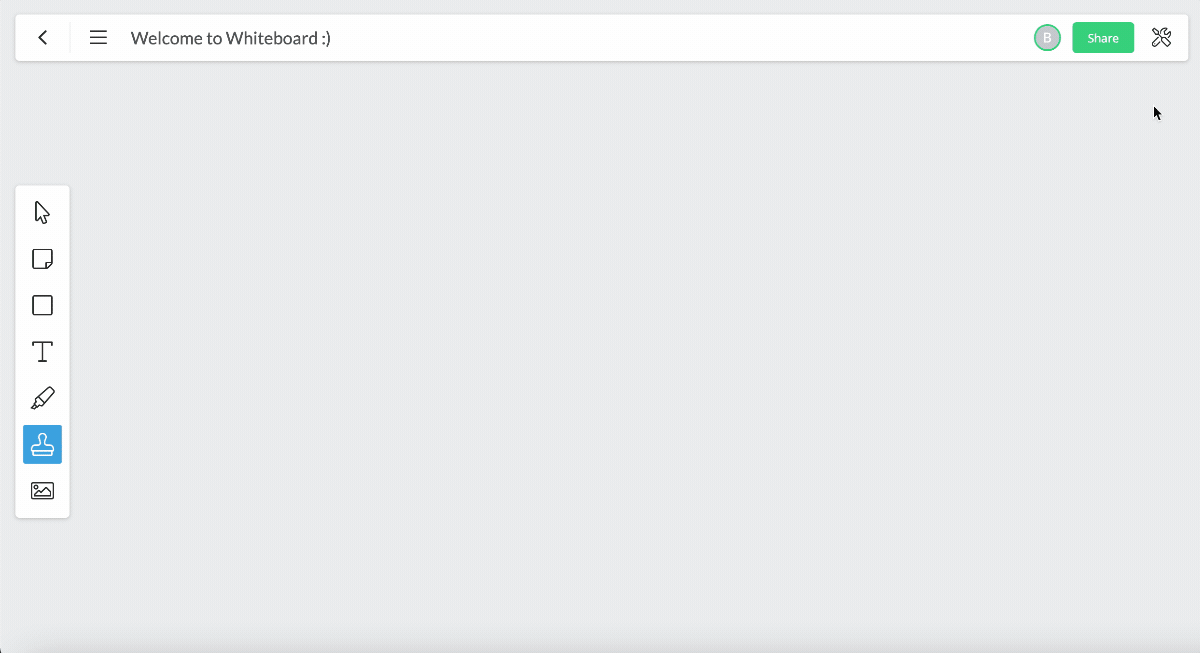
How did the product development process evolve as you went along?
Arps: It was important that we never got consumed with features for the sake of features and lost sight of the customers who would be using the product. Input from the Brightidea Professional Services team was important because they could point to actual situations and use cases from real customers. Their input drove quite a few of the features, such as the selection of templates, that evolved significantly from the initial product brief. We also conducted extensive customer testing and that feedback was invaluable in informing changes and refinements to the products, for example, anything from which shapes are available to how users interact with the toolbar, all were evolved and changed due to feedback we got directly from alpha testing and customer feedback.
Clobus: To add on, building the product was a puzzle we started putting together with only some of the pieces. As we moved forward, the shape of the missing pieces became more clear as we gained insights from the early feedback and continually spot checking ourselves to confirm we were building the right tools for our customers.
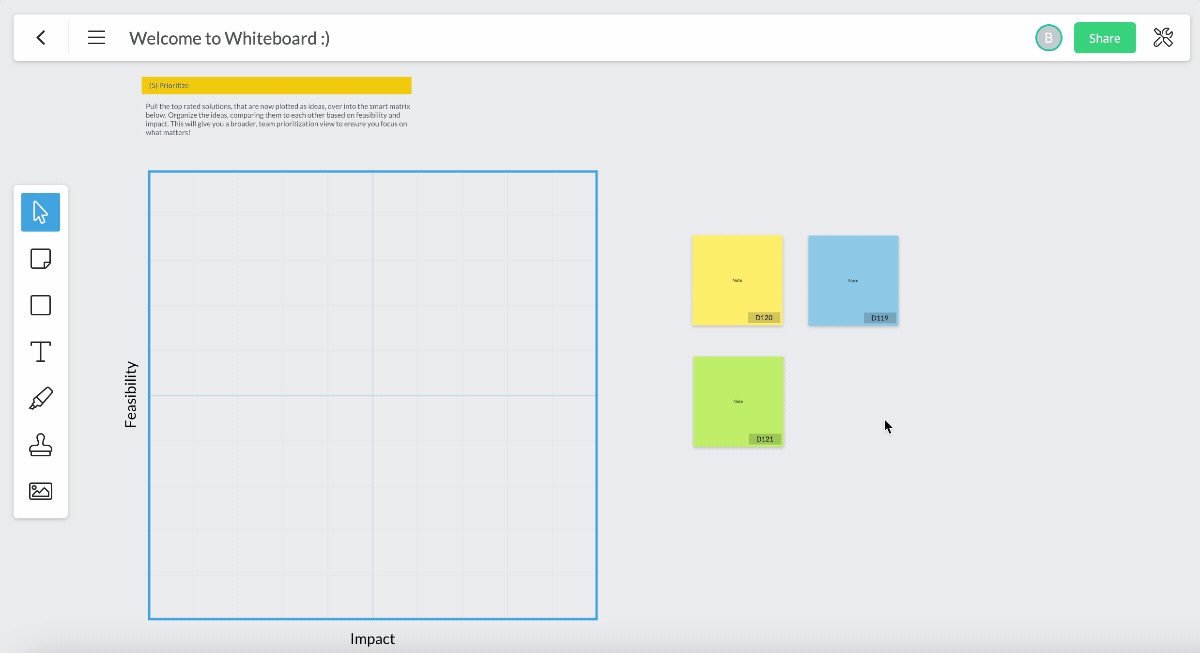
What will stand out to users when they begin using Brightidea Whiteboard?
Clobus: If you’ve used collaboration tools—physical whiteboards or digital whiteboard tools—Brightidea Whiteboard will be immediately familiar. Because of that familiarity, users will quickly arrive at that “ah-hah” moment when they see the connection to the Brightidea platform. Because of that connection, they’ll be able to turn sticky notes into ideas in the pipeline with a click. They’ll also be able to use the Smart Matrix to prioritize ideas—effectively it acts as a visual scorecard and all the data is synced to the pipeline. Facilitators will really appreciate that it’s all under one roof, it’s easy to get things into Brightidea and no ideas get lost. As we continue to evolve the product, there will be even more smart features that we can’t wait for them to get their hands on.
“If you’ve used collaboration tools—physical whiteboards or digital whiteboard tools—Brightidea Whiteboard will be immediately familiar.” Arps: If someone is unfamiliar with Brightidea, they’ll see a feature like the Smart Matrix and maybe think “that’s cool,” but as soon as they realize the connectivity embedded within this system—the live score updating, the data that’s being tracked, the connection to innovation pipeline—they’ll recognize that Brightidea Whiteboard is much more than meets the eye and more than other whiteboard tools in the market.
From a user experience perspective, our goal is to fill every single gap in people’s workflow like putty in the cracks, so we’re making their day more efficient, and they don’t even have to think about it. We don’t want to change a user’s process or the way that they interact with people. We just want to amplify it and make it better so they have more powerful levers to respond with, and day-to-day operations become more efficient and more nimble.
Brightidea Whiteboard is almost a choose-your-own-adventure; there’s not a specific path that’s going to make you an expert, because it’s there to respond to however you want to use it. If you’re the person that just needs a place for your brain dumps and to organize independent thoughts, it will do that. And if you’re the person who wants to gather 50 of your peers in there for a structured brainstorm session, it will do that too.
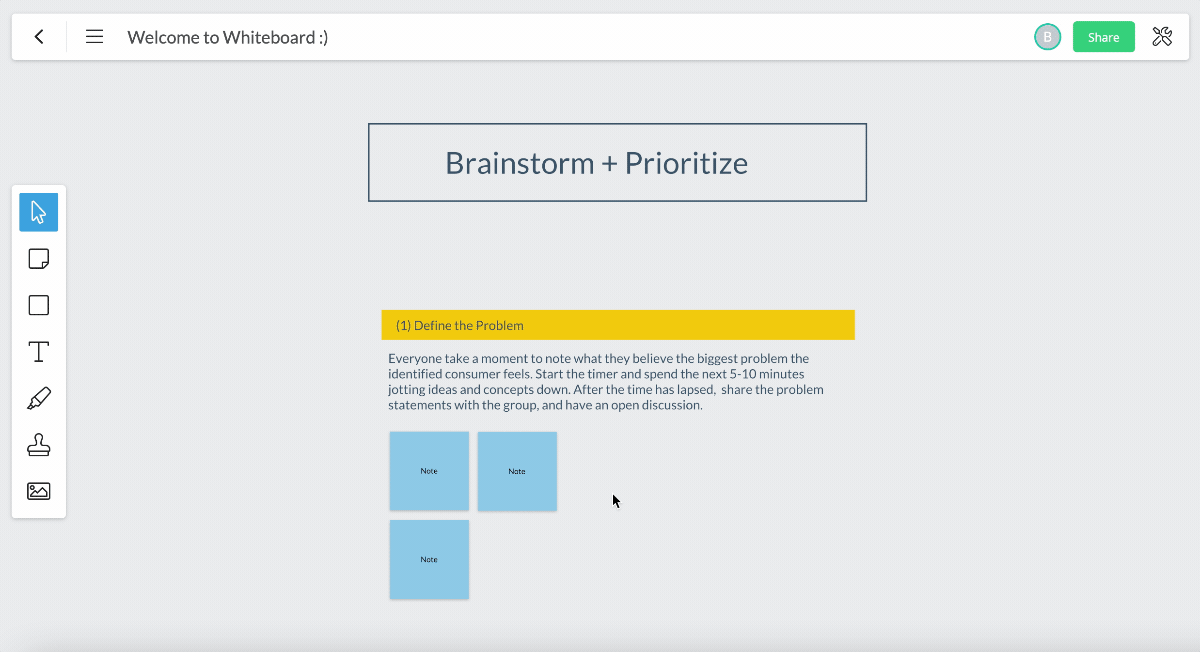
What’s next for Brightidea Whiteboard?
Clobus: We’re already working on ways to add features and functionality. Just from my personal use, I’ve already discovered different ways to use it that I didn’t expect at the start. From a blank canvas for ideas to organizing my day, creating checklists, and just getting stuff done. I’m excited to see what our customers do with it and all the different ways they’ll use the whiteboard and, hopefully, they’ll share the ideas they have for making the product better in our Customer IdeaSpace—we’re listening!
If you are looking for a better way to brainstorm and then move ideas into reality, give Brightidea Whiteboard a try. It’s free.
